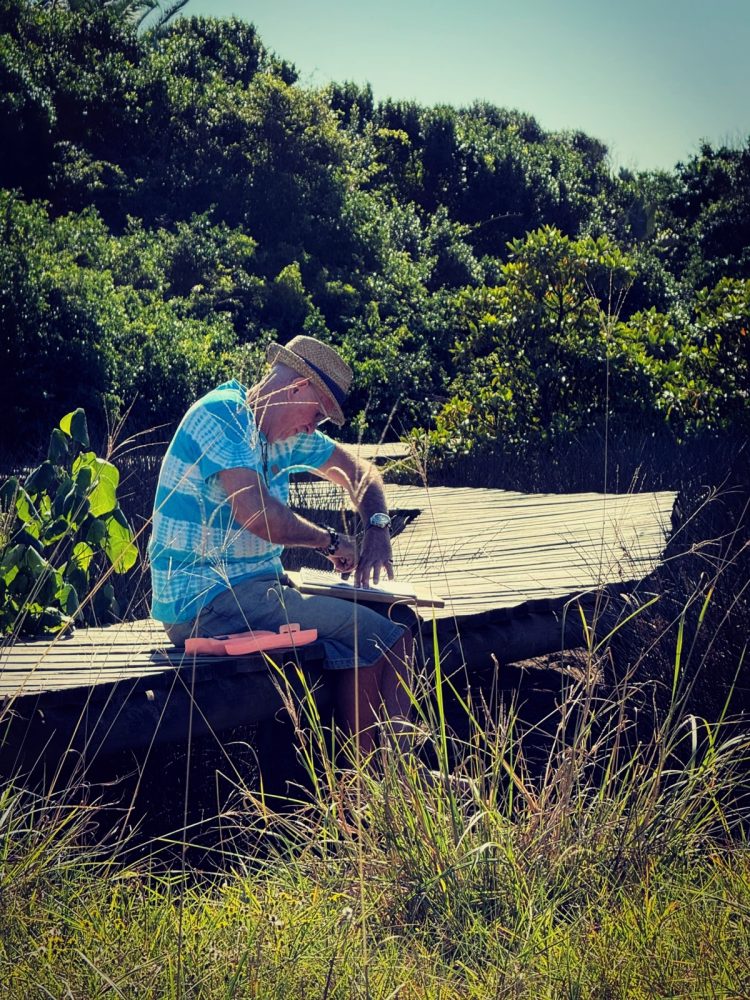When I work outdoors, I travel light. Charcoal, soft pastels, pastel pencils, a sketchbook, drawing board, and enough awareness to catch what might otherwise go unseen. I don’t take paints. They’ve never felt necessary. For me, it’s charcoal and pastel that respond best to what I’m drawn to: the shifting light, the textures of place, and the quiet invitation to observe more deeply than I did the day before.
The Beachwood Mangroves are a favourite. I’ve walked there at different times of day, but it’s the early morning or late afternoon that holds the richest atmosphere. The light then doesn’t shout; it drapes, glows, slips between branches and tide pools, casting long shadows and subtle reflections. It’s rarely still, which is part of what keeps me returning. Nothing is ever the same. The water, the birdsong, even the ocean’s cadences, seem to rearrange themselves according to some quiet choreography I’ll never quite pin down.
I don’t arrive with a finished image in mind. What I look for is a flicker; a certain line of movement, or the way colour shifts in a puddle of water. Sometimes it’s the contrast of light against dense foliage. Other times it’s something I can’t name. I follow that tug until I find a place to stop and begin. From there, the work becomes a kind of listening. I let the charcoal move first, sketching out the gesture of things, not their outlines. I’m not trying to capture a scene; I’m trying to respond to the quality of light in that moment.
Charcoal suits this process because it demands immediacy. It’s physical and intuitive. The marks are bold, but also fragile. I can erase, smudge, shift — but only so far. The paper collects everything: windblown dust, the imprint of a fingertip, a tremor in the hand. It reminds me that I’m in the moment, not removed from it.
When I reach for pastel, it’s to bring in light. I might touch in pale blues where the ocean holds the sky, or drag a whisper of ochre across the sand. The pastels crumble, and my fingers do the rest, pressing, blending, softening, coaxing tone from the edge of a shadow. There’s no room for overworking. Each mark has to count.
Sometimes I’ll sketch for an hour, perhaps ten minutes. Or not at all. The act of watching, listening, is enough. I’ll sit and track how the sun falls through the coastal casuarina or watch as the early evening mist creeps in, softening everything to a blur. These are the moments that feed the work, even if no drawing comes from them. Observation is part of the practice, maybe the most important part.
Cézanne once said, “A time is coming when a carrot, freshly observed, will trigger a revolution.” That line stays with me. It speaks to the radical act of paying attention. Of not overlooking what’s small or ordinary, but instead seeing it as if for the first time. In those early or late hours at the edge of the ocean or beneath the canopy of trees, I find myself doing just that — not simply recording, but receiving.
I don’t think of these drawings as studies or products. They’re more like conversations. Each one reflects where I was in that moment, physically, emotionally, and atmospherically. Some are resolved. Others fall apart. It doesn’t matter. What stays with me is the experience of seeing fully, of responding without hesitation, of feeling part of something wider than myself.
This is what en plein air means to me. Not just working outdoors, but entering into a relationship with a place. Letting it guide the hand. Letting the breeze lift the edges of the page, the sounds of birdsong or rustling leaves become part of the rhythm. There’s a tenderness in that, and a kind of humility, too. The light doesn’t wait. The tide doesn’t pause. My task is simply to show up and do what I can to honour the moment.
In the end, the drawings are traces. Not of what I saw, exactly, but of how I saw it. The shape of light on water. The hush beneath the trees. The way a shadow leaned across the sand just before dusk. These moments pass quickly, but the act of attending to them leaves a mark — one that runs deeper than the paper itself.
Guy McGowan
WASA representative in Durban, KwaZulu-Natal
Chairperson of North Coast Artists, KZN

